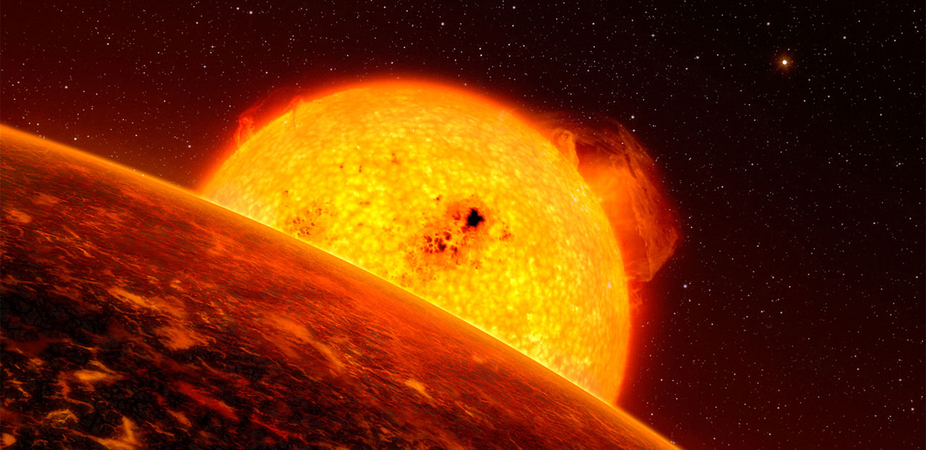Why Haven't We Encountered Aliens Yet? The Answer Could be Climate Change


This article was originally published at The Conversation. The publication contributed the article to Live Science's Expert Voices: Op-Ed & Insights.
Enrico Fermi, when asked about intelligent life on other planets, famously replied, “Where are they?” Any civilisation advanced enough to undertake interstellar travel would, he argued, in a brief period of cosmic time, populate its entire galaxy. Yet, we haven’t made any contact with such life. This has become the famous "Fermi Paradox”.
Various explanations for why we don’t see aliens have been proposed – perhaps interstellar travel is impossible or maybe civilisations are always self-destructive. But with every new discovery of a potentially habitable planet, the Fermi Paradox becomes increasingly mysterious. There could be hundreds of millions of potentially habitable worlds in the Milky Way alone.
This impression is only reinforced by the recent discovery of a “Mega-Earth”, a rocky planet 17 times more massive than the Earth but with only a thin atmosphere. Previously, it was thought that worlds this large would hold onto an atmosphere so thick that their surfaces would experience uninhabitable temperatures and pressures. But if this isn’t true, there is a whole new category of potentially habitable real estate in the cosmos.
Finding ET
So why don’t we see advanced civilisations swarming across the universe? One problem may be climate change. It is not that advanced civilisations always destroy themselves by over-heating their biospheres (although that is a possibility). Instead, because stars become brighter as they age, most planets with an initially life-friendly climate will become uninhabitably hot long before intelligent life emerges.
The Earth has had 4 billion years of good weather despite our sun burning a lot more fuel than when Earth was formed. We can estimate the amount of warming this should have produced thanks to the scientific effort to predict the consequences of man-made greenhouse-gas emissions.
These models predict that our planet should warm by a few degrees centigrade for each percentage increase in heating at Earth’s surface. This is roughly the increased heating produced by carbon dioxide at the levels expected for the end of the 21st century. (Incidentally, that is where theIPCC prediction of global warming of around 3°C centigrade comes from.)
Breaking space news, the latest updates on rocket launches, skywatching events and more!
Over the past half-billion years, a time period for which we have reasonable records of Earth’s climate, the sun’s surface temperature increased by 4% and terrestrial temperatures should have risen by roughly 10°C. But the geological record shows that, if anything, on average temperatures fell.
Simple extrapolations show that over the whole history of life, temperatures should have risen by almost 100°C. If that were true, early life must have emerged upon a completely frozen planet. Yet, the young Earth had liquid water on its surface. So what’s going on?
Get lucky
The answer is that it us not just the sun that has changed. The Earth also evolved, with the appearance of land plants around 400m years ago changing atmospheric composition and the amount of heat Earth reflects back into space. There has also been geological change with the continental area steadily growing through time as volcanic activity added to the land-mass and this, too, had an effect on the atmosphere and Earth’s reflectivity.
Remarkably, biological and geological evolution have generally produced cooling and this has compensated for the warming effect of our ageing sun. There have been times when compensation was too slow or too fast, and the Earth warmed or cooled, but not once since life first emerged has liquid water completely disappeared from the surface.
Our planet has therefore miraculously moderated climate change for four billion years. This observation led to the development of the Gaia hypothesis that a complex biosphere automatically regulates the environment in its own interests. However, Gaia lacks a credible mechanism and has probably confused cause and effect: a reasonably stable environment is a precondition for a complex biosphere not the other way around.
Other inhabited planets in the universe must also have found ways to prevent global warming. Watery worlds suitable for life will have climates that, like the Earth, are highly sensitive to changing circumstances. The repeated cancelling of star-induced warming by “geobiological” cooling, required to keep such planets habitable, will have needed many coincidences and the vast majority of such planets will have run out of luck long before sentient beings evolved.
However, the universe is immense and a few rare worlds will have had the necessary good fortune. It may just be that Earth is one of those lucky planets – a precious, fragile jewel in space. So, perhaps inevitably, climate change will remain a bane of the continued existence of life on such planets.
Next, read this: Habitable exoplanets are bad news for humanity.
David Waltham is the author of Lucky Planet (http://davidwaltham.com/lucky-planet/).
This article was originally published on The Conversation. Read the original article. Follow all of the Expert Voices issues and debates — and become part of the discussion — on Facebook, Twitter and Google +. The views expressed are those of the author and do not necessarily reflect the views of the publisher. This version of the article was originally published on Live Science.
